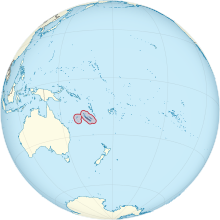
Back Kaledonia Barô ACE Nieu-Kaledonië Afrikaans Neukaledonien ALS ኑቨል ካሌዶኒ Amharic Nueva Caledonya AN Nīwe Scotta Ēaland ANG नया कैलेडोनिया ANP كاليدونيا الجديدة Arabic نيو كاليدونيا ARZ Nueva Caledonia AST
New Caledonia Nouvelle-Calédonie (French) | |
|---|---|
| Motto: English: "Land of speech, land of sharing" | |
| Anthem: La Marseillaise ("The Marseillaise") "Soyons unis, devenons frères"[nb 1] | |
Location of New Caledonia | |
| Sovereign state | |
| Annexed by France | 24 September 1853 |
| Overseas territory | 1946 |
| Nouméa Accord | 5 May 1998 |
| Capital and largest city | Nouméa 22°16′S 166°28′E / 22.267°S 166.467°E |
| Official languages | French |
| Recognised regional languages | |
| Demonym(s) |
|
| Government | Devolved parliamentary dependency |
| Emmanuel Macron | |
| Louis Le Franc | |
| Louis Mapou | |
| Veylma Falaeo | |
• President of the Customary Senate | Yvon Kona |
| Legislature | Congress |
| French Parliament | |
• Senate | 2 senators (of 348) |
| 2 seats (of 577) | |
| Area | |
• Total | 18,575[1] km2 (7,172 sq mi) |
• Land | 18,275 km2 (7,056 sq mi) |
• Water (%) | 1.6 |
| Highest elevation | 1,628 m (5,341 ft) |
| Population | |
• 2019 census | 271,407[2] (184th) |
• Density | 14.5/km2 (37.6/sq mi) (200th) |
| GDP (nominal) | 2019 estimate |
• Total | US$9.44 billion[3] |
• Per capita | US$34,780[3] |
| Currency | CFP franc (₣) (XPF) |
| Time zone | UTC+11:00 |
| Driving side | Right |
| Calling code | +687 |
| ISO 3166 code | |
| Internet TLD | .nc |
| This article is part of a series on the |
| Administrative divisions of France |
|---|
 |
| Administrative divisions |
| Intercommunality |
| Communes |
| Overseas France |
| Geocodes of France |
|
|
|
|
New Caledonia (/ˌkælɪˈdoʊniə/ ⓘ KAL-ih-DOH-nee-ə; French: Nouvelle-Calédonie [nuvɛl kaledɔni] ⓘ)[nb 2] is a group of islands in the southwest Pacific Ocean, 220 km (140 mi) southwest of Vanuatu and 1,210 km (750 mi) east of Australia.[5] Located 16,100 km (10,000 mi) from Metropolitan France, it forms a sui generis collectivity of the French Republic, a legal status unique in overseas France and enshrined in a dedicated chapter of the French Constitution.
The archipelago, part of the Melanesia subregion, includes the main island of Grande Terre, the Loyalty Islands, the Chesterfield Islands, the Belep archipelago, the Isle of Pines, and a few remote islets.[6] The Chesterfield Islands are in the Coral Sea. French people, especially locals, call Grande Terre le Caillou,[nb 3] a nickname also used more generally for the entire New Caledonia.[7] Pro-independence parties refer to their country as (la) Kanaky[nb 4] coined in the 1980s after the Kanak, the collective name for its indigenous Melanesians who make up 41% of New Caledonia's population. New Caledonia is one of the European Union's Overseas Countries and Territories (OCTs),[8] but it is not part of the European Union.[9]
New Caledonia has a land area of 18,575 km2 (7,172 sq mi) divided into three provinces. The North and South Provinces are on the New Caledonian mainland, while the Loyalty Islands Province is a series of four inhabited islands off the east coast of mainland (from north to south: Ouvéa, Lifou, Tiga, and Maré). New Caledonia's population of 271,407 (October 2019 census)[10] is of diverse origins and varies by geography; in the North and Loyalty Islands Provinces, the indigenous Kanak people predominate, while the wealthy South Province contains significant populations of European (Caldoches and Metropolitan French), Kanak, and Polynesian (mostly Wallisian) origin, as well as smaller groups of Southeast Asian, Pied-Noir, and North African heritage. The capital of New Caledonia is Nouméa.[5]
Cite error: There are <ref group=nb> tags on this page, but the references will not show without a {{reflist|group=nb}} template (see the help page).
- ^ "New Caledonia". Central Intelligence Agency. 6 December 2023. Archived from the original on 7 April 2022. Retrieved 25 January 2021 – via CIA.gov.
- ^ "Structure de la population et évolutions". Nouméa: Institute of Statistics and Economic Studies (ISEE-NC). Archived from the original on 13 November 2014. Retrieved 16 November 2014.
- ^ a b "Evolution du PIB et du PIB par habitant". Nouméa: Institute of Statistics and Economic Studies (ISEE-NC). Archived from the original on 14 May 2021. Retrieved 14 May 2021.
- ^ "LOI no 1999-209 du 19 mars 1999 organique relative a la Novelle Calédonie" (PDF). Journal officiel de la République française. 21 March 1999. p. 4223. Archived from the original (PDF) on 14 June 2007.
- ^ a b "Présentation". Nouvelle-caledonie.gouv.fr (in French). Archived from the original on 30 October 2012. Retrieved 30 January 2013.
- ^ Cite error: The named reference
pres-omwas invoked but never defined (see the help page). - ^ David Stanley (1989). South Pacific Handbook. David Stanley. p. 549. ISBN 978-0-918373-29-8. Archived from the original on 13 April 2016. Retrieved 18 October 2015.
- ^ "European Union Overseas Territories and Countries". OCTA. Archived from the original on 10 December 2023. Retrieved 26 December 2023.
- ^ "Overseas Countries and Territories - European Commission". international-partnerships.ec.europa.eu. Archived from the original on 27 December 2023. Retrieved 26 December 2023.
- ^ "268 767 habitants en 2014". Nouméa: Institute of Statistics and Economic Studies (ISEE-NC). Archived from the original on 13 November 2014. Retrieved 16 November 2014.


